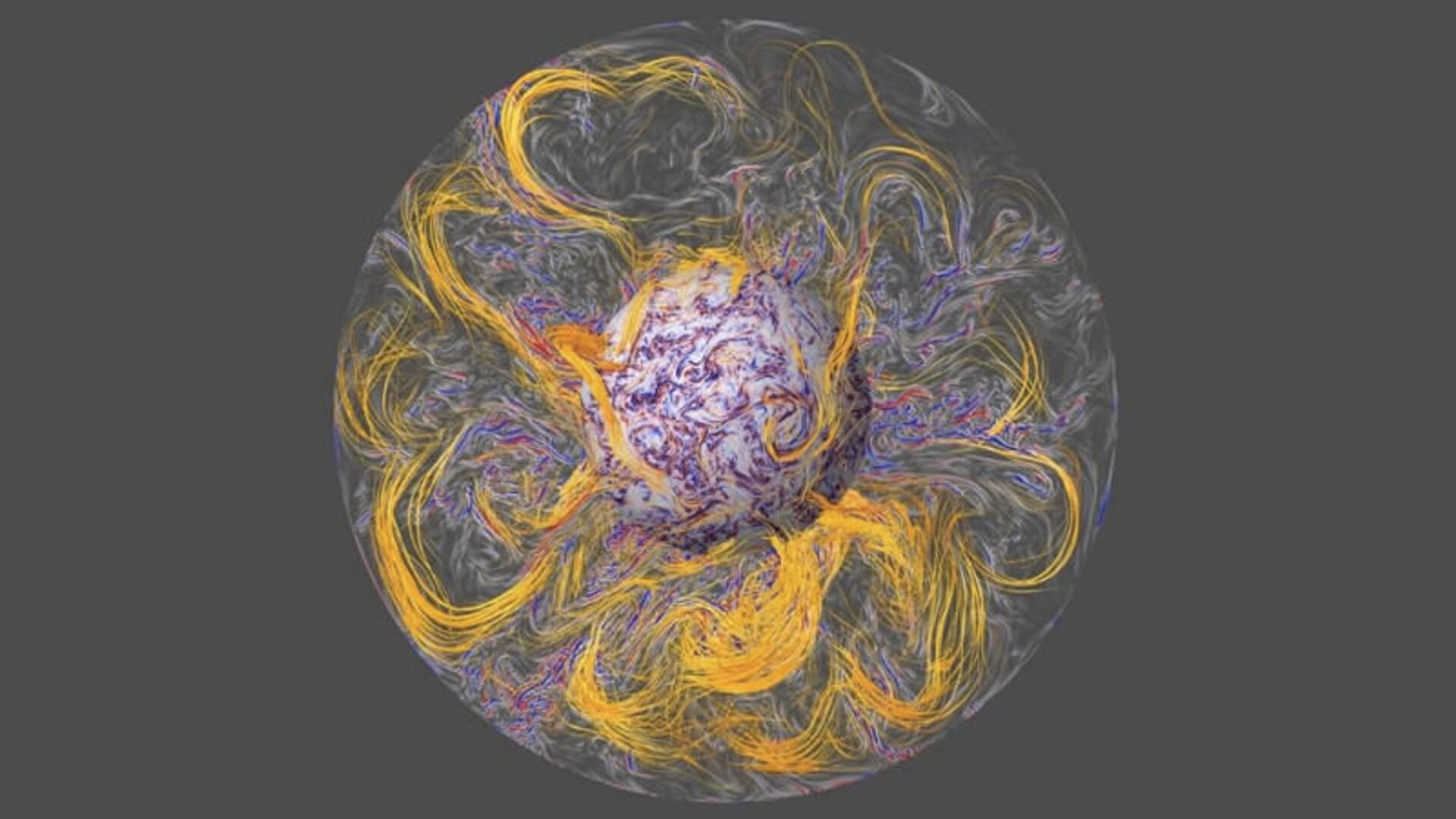How Likely is Earth's Magnetic Field Flip to Trigger Doomsday Scenario for Our Planet?
12:25 GMT 25.11.2021 (Updated: 19:33 GMT 03.11.2022)

© Photo : Aubert et al./IPGP/CNRS Photo library
Subscribe
Earth's magnetic field – vital to all life on our planet – protects the ozone layer from solar winds, cosmic rays, and harmful radiation. The field is most concentrated at the poles but sometimes they switch, with one such event, called the Laschamp excursion, occurring around 42,000 years ago and lasting around 1,000 years.
Should humanity be concerned about a possible geomagnetic reversal of Earth’s poles any time soon? This question has recently been thrust into the spotlight. The flipping of planet Earth's magnetic pole is something that occurs cyclically. In the past 20 million years or so, the magnetic field, which protects our planet’s ozone layer from solar winds, cosmic rays, and harmful radiation, has flipped every 200,000 to 300,000 years.
The Aurora Borealis is a visual reminder of the strength of Earth’s magnetic field which protects us from the solar radiation which would surely eradicate all life on Earth if not mitigated. pic.twitter.com/4I5vTtzg7r
— Raj Keplerhume (@RajKeplerhume) November 2, 2021
However, with observations suggesting that it has been more than twice that long since the last one, speculation is rife over the possible implications of this delay.
Earth’s ‘Shield’
Earth’s magnetic field originates in its core. The solid iron core is surrounded by an ocean of hot (over 9,000°F – 5,000°C) molten metal, which generates an electric current as it moves. The temperatures here are even hotter than the outer layer of the Sun. It is this heat that drives convection currents in the outer core around the solid iron inner core, generating a magnetic field via the dynamo effect.

Dynamic Earth - Earth’s Magnetic Field
This extends out into the space around our planet, shielding it from solar wind, which is full of charged particles, magnetic clouds, and radiation, and allowing life on Earth to exist. It is this magnetic field that created the magnetic poles, situated near the geographical poles.
The geographical poles do not really move over time, unlike geomagnetic poles. For example, in 2015, the geomagnetic North pole was situated on Ellesmere Island, Canada, while the geographical North pole remained at the “centre” of the globe.
As Earth’s magnetic field is not 100 percent stable, fluctuations in the strength of the field can result in the poles “migrating” until they “trade places," or “flip.” When the North Pole becomes the South Pole and vice versa, the effect is called a magnetic reversal.
Geomagnetic ‘Flip’ Fallout
It is suggested that the last flip of Earth’s magnetic poles – known as the Laschamp excursion –occurred around 42,000 years ago, accompanied by a weakening in the magnetic field. The first evidence of the event was discovered in the Laschamp lava flows, the French Massif Central, in the 1960s. Scientific opinion leans towards the theory that this caused a global environmental crisis towards the end of the Glacial Period.
The weakening of the Earth's magnetic field during that event is deemed to have damaged the ozone layer to the extent that it triggered drastic weather changes, sparking the extinction of megafauna species and even the Neanderthals – a group of archaic humans who emerged about 200,000 years ago during the Pleistocene Epoch. No other “flipping” events seem to have wrought such dramatic changes in plant or animal life.

Guido Camia dressed as a Neanderthal Cave man lights a campfire in Chianale, in the Italian Alps, near the French border, on August 7, 2019.
© AFP 2023 / MARCO BERTORELLO
Most scientists dismiss the possibility of a doomsday scenario. According to the US National Aeronautics and Space Administration (NASA), Earth's magnetic field weakens and strengthens all the time, and while a weaker field would lead to increased solar radiation on Earth, the thick atmosphere offers efficient protection against the solar wind.
In a repetition of the Laschamps excursion, according to space researcher Daniel Baker, some parts of the planet could become uninhabitable due to radiation.
The strength of mother Earth's magnetic field is 20 μT - 70 μT depending on where you live. This magnetic field is a strong biological growth factor.
— N'Golo ▂▃▅ 65%… 🙏 (@NgoloTesla) October 14, 2020
It's also notable that the south pole of a magnet is typically way more beneficial (geographic north pole, Hyperborea etc) pic.twitter.com/17hE42PDtk
Human health would be affected, with cancer one of the side effects, besides radiation poisoning and radiation-triggered mutations. Navigation systems based on the Earth’s magnetic field would also have to be recalibrated. Disorientation of animals, in the case of a sudden realignment, could lead to mass extinctions.
Even now, satellites and spacecraft passing through the South Atlantic Anomaly (SAA) – a quirky dent between South America and South Africa, where Earth’s magnetic field is weaker than in other areas of the planet – experience glitches. There exists an opinion that the SAA is proof of a looming magnetic flip. However, fluctuations in Earth’s magnetic field can occur without resulting in any reversal, and scientists have not been able to predict when the next major flip might happen.
